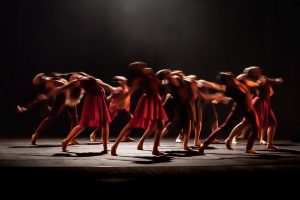Reflections: A Look Back at the First Year of the Project
The Future of Human Reproduction project has just celebrated its one-year anniversary. Interviews with the FoHR team reveal the successes and challenges of the first year of working on an exploratory, interdisciplinary humanities and social sciences research programme.
By Dr Zoe Bolton, published 22nd June 2023
The Future of Human Reproduction (FoHR) is funded by a Wellcome Research Development Award. This is research funding but not as we know it… There are no official milestones, no pre-determined outputs and no Gantt chart! Instead, Wellcome has granted the FoHR team the freedom to be truly exploratory, to take risks, push academic boundaries, and find new ways of working – even to fail.
In return, the team is tasked with developing innovative new interdisciplinary methods and research agendas to explore the many conceptual and ethical issues raised by advancements in reproductive technologies. So, how is this ambitious and unique research programme going? After its first year, what learnings have transpired and what challenges? In interviews conducted with the team by FoHR Research Associate, Dr Cronan Cronshaw, several key themes emerged.
Transcending disciplinary boundaries
Unsurprisingly, given that the team is drawn from six different disciplines, everyone had something to say about interdisciplinarity, and the benefits and challenges of working with colleagues from other disciplines.
 Interdisciplinary collaboration was seen as exciting and full of potential for broadening horizons, with people’s own disciplines being used as anchor points from which to expand knowledge. Team members enjoyed strengthening their understanding of other disciplines, through discipline-hopping sessions, and looking at their own disciplines in a new way.
Interdisciplinary collaboration was seen as exciting and full of potential for broadening horizons, with people’s own disciplines being used as anchor points from which to expand knowledge. Team members enjoyed strengthening their understanding of other disciplines, through discipline-hopping sessions, and looking at their own disciplines in a new way.
In the interviews, most people focussed on similarities between disciplines and took pleasure in spotting commonalities. Several were pleasantly surprised and heartened to find methodological overlaps between disciplines – close reading was cited as an example – and the specific overlap between linguistics and legal issues was noted: ‘the law is also about definitions about what can be named as what’, said Professor Elena Semino, FoHR Co-Investigator. English Literature was seen as a bridging discipline capable of traversing and connecting other disciplines. Speculative Design was described in a similar way and thought to hold promise for coming up with ‘new ways’ to get ‘people to engage with bioethical issues about new technologies’.
While team members spoke more about similarity than about divergence, important differences were noted: in opinion, in approach, in epistemological frameworks and in basic assumptions. These were seen as a fruitful realm for exploration on the basis that untapped spaces of variation are where the most innovative work is likely to be done. In particular, there was an appetite for methods that go ‘beyond the textual’ and involve designing, objects, visual depictions, and AI. These were seen as holding promise for ‘massive innovation’.
In terms of transcending existing disciplinary boundaries, FoHR Co-Investigator, Dr Nicola Williams, suggested that the group could hack away at disciplinary walls because ‘it’s only in the last few hundred years that there were such things as academic disciplines – so why not go back to the past when everyone wrote about everything?’. In a similar vein, Professor Stephen Wilkinson, FoHR Principal Investigator, commented that, ‘the very disciplinary boundaries that we’re claiming to cross might themselves just be artefacts. If the ontology of the disciplines is itself an artefact, we probably need to problematise what that means’.
Given the centrality of interdisciplinarity to the programme, there was an appetite for more structured and explicit reflection on what disciplines are, why they are needed, and what interdisciplinarity might look like in the light of these discussions.
 As well as the benefits of interdisciplinary working, the interviews also revealed some challenges. Professor Stephen Wilkinson described the process as being ‘like a group of musicians who are doing semi-improvisation and you’re trying to stop it from just being a racket and make it sound good but, at the same time, each person has their own contribution to make’. Several members of the team also acknowledged that a lot of groundwork had to take place prior to anything more substantial or innovative happening because ‘learning about each other’s’ topics’ was a necessary precursor to the ‘exchanging of different ideas’.
As well as the benefits of interdisciplinary working, the interviews also revealed some challenges. Professor Stephen Wilkinson described the process as being ‘like a group of musicians who are doing semi-improvisation and you’re trying to stop it from just being a racket and make it sound good but, at the same time, each person has their own contribution to make’. Several members of the team also acknowledged that a lot of groundwork had to take place prior to anything more substantial or innovative happening because ‘learning about each other’s’ topics’ was a necessary precursor to the ‘exchanging of different ideas’.
The difficulty of getting out of disciplinary silos, especially when people feel safe within them, was also identified as a challenge; as was the problem of overlapping but conflicting vocabularies across disciplines: using the same words in different ways and not necessarily having an awareness of divergent meanings. The development of a ‘shared language’ was posited as a potential way to overcome these differences between disciplinary discourses.
Nurturing positive team dynamics
 The importance of using the first year to build strong relationships across the team also featured heavily in the interviews. The team was described as being in the process of learning to dance together: ‘It’s like we’re starting to learn different songs together, exchanging music. We watch people dancing, and we’re at the stage where we will start dancing together and form our own choreography. We’re not there yet, but that’s what we’re aiming to do’.
The importance of using the first year to build strong relationships across the team also featured heavily in the interviews. The team was described as being in the process of learning to dance together: ‘It’s like we’re starting to learn different songs together, exchanging music. We watch people dancing, and we’re at the stage where we will start dancing together and form our own choreography. We’re not there yet, but that’s what we’re aiming to do’.
There was a consensus that the team was friendly and supportive, and the group was variously described as ‘the best part of the project’, ‘intellectually diverse’, ‘amazing’, and ‘brilliant’. The dynamics within the team were characterised as fostering free, open, and easy communication: ‘a safe space to say things you might think make you sound stupid’. Trust was viewed as essential when working in an exploratory and collaborative way, with team members suggesting that personal doubt was allayed by the thought of shared responsibility and teamwork: ‘Trust is a big thing in this project. I am trusting that everything will work because of the people on the project’, said Dr Kirsty Dunn, FoHR Co-Investigator.
There was widespread enjoyment of the in-person meetings and workshops held regularly on Fridays. Professor Elena Semino described the sessions as ‘a guilty pleasure’, ‘something that feels like not work’, and ‘the best bit of my week, absolutely, hands down, completely’. Fun was a word that was used frequently to describe the group’s in-person sessions, which were seen by the team to afford easy conversation and exchange of thoughts, and as fertile ground for the emergence of unexpected ideas. It was suggested that after activities and workshops, it would be beneficial for the group to engage in reflective exercises to take stock, plan, share, learn and keep momentum.
Some colleagues in the FoHR team reported enjoying the experience of working on the programme so much that they wished to continue collaborating beyond the project: ‘I’m hoping that there’s some long-term working relationships that come out of it as well because I’ve really enjoyed working with the individual team members as much as I have the topics and the grant’.
Fostering responsible debate
A theme that came up repeatedly in the interviews was the question of how best to negotiate the ‘controversial’, ‘political’, and ‘exceptionally sensitive territory’ of future reproductive technologies. A number of team members underscored the importance of contributing to the quality of debate, which is ‘currently very low because of polarisation and populism’. It was felt that this could be achieved in several ways: through publications, other written outputs, podcasts, and discussions with stakeholders.
Another area of interest was related to discourses around future reproductive technologies. This includes moral panics and the ways in which ethical issues manifest themselves through language and in how people talk about, and react to, reports of scientific and technological developments. This was a focus that several members of the team felt excited and inspired by.
Building the project’s legacy
Even though the programme has only been running for a year, the interviews showed that team members were already thinking about the legacy of the project. The FoHR team’s hopes included: fostering sustainable internal and external alliances that will last beyond the lifetime of the grant; developing global connections and building an international network of scholars to diversify perspectives; influencing key stakeholders; producing good quality outputs; collaborating beyond the life of the project; and securing further funding.
More than one team member expressed a desire to create a legacy of exciting and interesting work for other academics to engage with and carry forward: ‘giving people a toolbox they can use’ and ‘coming up with some ideas that other people will pick up and run with’.
Finding the right balance
 Overall, the interviews suggest that the next phase of the programme will be about finding the right balance between: disciplines; voices within the team; exploration, goal-setting and directive action; democracy and leadership; smaller, focused workgroups and the cohesion of the group as a whole; and ‘order’ and ‘chaos’.
Overall, the interviews suggest that the next phase of the programme will be about finding the right balance between: disciplines; voices within the team; exploration, goal-setting and directive action; democracy and leadership; smaller, focused workgroups and the cohesion of the group as a whole; and ‘order’ and ‘chaos’.
Achieving balance in these different areas will, to borrow the musical analogy cited earlier, result in harmonious improvisation enabling the team to work collaboratively to deliver on its ambitious aims.
This article draws extensively on interviews conducted with the FoHR team by Dr Cronan Cronshaw, FoHR Research Associate, and the materials resulting from those interviews.
Other Posts
- “The genetics bomb could be a disaster”: Author Simon Mawer on Mendel’s Dwarf
- Spotlight on CRISPR-Cas9
- Exhibition Review: Genetic Automata
- A Look Back at 2023
- Explainer: Human Stem Cell Based Embryo Models
- Is it time to revisit the 14-day rule?
- Gifting the Womb: The UK’s First Uterus Transplantation
- Discipline Hopping: UK Law and Emerging Reproductive Technologies
- Book Review – Eve: The Disobedient Future of Birth
- Ectogenesis: A Retrospective
